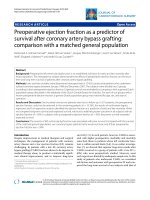Thuyết trình The Term Structure as a Predictor of Real Economic Activity
Bạn đang xem bản rút gọn của tài liệu. Xem và tải ngay bản đầy đủ của tài liệu tại đây (2.55 MB, 51 trang )
LOGO
The Term Structure as a
The Term Structure as a
Predictor of Real Economic
Predictor of Real Economic
Activity
Activity
Arturo Estrella; Gikas A.Hardouvelis – The Journal of Finance
Arturo Estrella; Gikas A.Hardouvelis – The Journal of Finance
Reporters:
Reporters:
•
Phan Ngọc Chị
Phan Ngọc Chị
•
Đoàn Thị Cẩm Lan
Đoàn Thị Cẩm Lan
•
Cao Xuân Hải
Cao Xuân Hải
•
Nguyễn Ngọc Minh Tuấn
Nguyễn Ngọc Minh Tuấn
Professor:
Professor:
PhD. Trần Ngọc Thơ
PhD. Trần Ngọc Thơ
Contents
INTRODUCTION1
REVIEW2
DATA AND METHODS3
USEFULNESS OF THE TERM STRUCTURE
4
CONCLUSIONS6
EVALUATING THE INFORMATION5
Contents
INTRODUCTION
1
REVIEW2
DATA AND METHODS3
INFORMATION IN THE TERM STRUCTURE
4
CONCLUSIONS6
EVALUATING THE INFORMATION5
1. INTRODUTION
1.1. Abstract
A positive slope of the yield curve is associated with a
future increase in real economic activity: : consumption
(nondurables plus services), consumer durables, and
investment.
It has extra predictive power over the index of leading
indicators, real short-term interest rates, lagged growth in
economic activity and lagged rates of inflation.
It outperforms survey forecasts, both in – sample and out –
of – sample. Historically, the information in the slope
reflected factors that were independent of monetary policy,
and thus the slope could have provided useful information
both to private investors and to policy makers.
Durables & Non- Durables Goods
Durables have an extended product life and are
not worn out or consumed quickly when you use
them. Since they're made to last, durable goods
are typically more expensive than non-durable
goods that have to be purchased over and over
again.
Consumer durable goods include cars, household
goods (home appliances, consumer electronics,
furniture, etc.), sports equipment, firearms, and
toys.
nondurable goods include fast moving consumer
goods such as cosmetics, food, fuel, beer,
cigarettes, medication, office supplies, clothing,…
www.themegallery.com
Company Logo
1. INTRODUTION
The flattening of the yield curve in 1988 and its
inversion in early 1989 have been interpreted as
evidence that a recession is imminent.
Presumption that a flattening of the yield curve
predicts a drop in future spot interest rates.
Then, these lower rates are associated with a lower
level of real GNP.
Recent empirical work: changes in the slope of the
yield curve predict the correct direction of future
changes in spot rates. But there is little on changes
in real economic activity.
The yield curve can predict future changes in real
output would be very impressive.
Type of the yield curve
www.themegallery.com
Company Logo
1. INTRODUTION
www.themegallery.com
Company Logo
Predictability of changes in real output is
associated with other equally important
questions:
How much extra information is there in
the term structure that is not readily
available in other published statistics?
Should the term structure be included in
the list of leading indicators?
1. INTRODUTION
Should monetary policy use the term
structure to extract information about
future output, or is it the case that the
yield curve reflects expected monetary
actions alone?
These are concerns that currently
preoccupy the Federal Reserve, for in the
latter case the slope of the yield curve
would have no extra useful information
for the conduct of monetary policy.
www.themegallery.com
Company Logo
Contents
REVIEW
2
INTRODUCTION1
DATA AND METHODS3
USEFULNESS OF THE TERM STRUCTURE
4
CONCLUSIONS6
EVALUATING THE INFORMATION5
2. REVIEW
2.1. Term structure has predictive power:
Fama (1984) examines 1- to 6-month Treasury
bill rates form 1959 to 1982 and finds that
forward rates predict the correct direction of
subsequent changes in short-term rates.
Mankiw and Miron (1986) find strong predictive
ability prior to the establishment of the FED using
3- and 6-month rates.
Hardouvelis (1988) examines the predictive
power of forward rates across recent monetary
regimes using weekly data on T-bill rates with
maturities that span 1 to 26 weeks. He finds no
necessary connection between the degree to
which the FED adheres to interest rate targeting
and the predictability of interest rates.
2. REVIEW
2.1. Term structure has predictive power:
Mishkin (1988) corroborates the evidence of
Fama (1984) and Hardouvelis (1988) using more
powerful estimation methods.
Fama and Bliss (1987) find that long-maturity
forward rates also have predictive power 2 to 4
years ahead.
Campbell and Shiller (1987) find evidence
consistent with the hypothesis that there is useful
information in the term structure about the future
evolution of interest rates.
2. REVIEW
2.2. Forward rates - future real rates and inflation:
Mishkin (1990) examines rates with maturities
that range from one to 12 months and finds that
most of the information in forward rates is about
future real rates of interest.
Fama (1990) finds that an increase in the spread
between the 5-year and 1-year bond yield
predicts and increase in the rate of inflation for
following 5 years and decrease for 1,2,3 years.
Evidence is consistent with the hypothesis that
the slope of the yield curve has predictive power
about real rate of interest.
2. REVIEW
2.3. Term structure predict real economic activity:
Kessel (1956) and Fama (1986) mentions this
empirical regularity but does not provide detailed
statistical evidence.
Laurent (1988) regresses the growth in real GNP
on lags of the spread between the 20-year bond
rate and FED fund rate. The sum of all lagged
spreads in positive but insignificant.
Harvey (1988) examines the term structure in the
context of CCAPM. He focuses on testing the
CCAPM and provides evidence on predictability
only up to 3 quarters into future. But the
predictability of the real term structure is mixed.
Consumption Capital Asset Pricing Model -
CCAPM
A financial model that extends the concepts of the
capital asset pricing model (CAPM).
The CCAPM uses consumption measures, in terms of a
consumption beta, in its calculation of a given
investment's expected return.
www.themegallery.com
Company Logo
Contents
INTRODUCTION1
REVIEW2
DATA AND METHODS
3
USEFULNESS OF THE TERM STRUCTURE
4
CONCLUSIONS6
EVALUATING THE INFORMATION5
3. DATA AND METHODS
3.1. Data and Definitions:
Real GNP is observed quarterly, from 1955 to
1988.
The dependent variable is the annualized
cumulative percentage change in seasonally
adjusted finally revised real GNP number based
on 1982 dollars.
k: forecasting horizon in quarters.
Y(t+k): level of real GNP during quarter t+k
Y(t,t+k): percentage change from current quarter
t to future quarter t+k
3. DATA AND METHODS
3.1. Data and Definitions:
The predictability of the annualized marginal
percentage change in real GNP form future
quarter t+k-j to future quarter t+k:
Observe that the cumulative percentage change
Yt,t+k is the average of consecutive marginal
percentage changes Y t+i-1, t+i for i = 1, 2, 3,
……., k. Hence, each Y t + i – 1, t + 1 provides
more precise information on how far into the
future the term structure can predict.
3. DATA AND METHODS
For simplicity, we use only two interest rates
to construct the slope of the yield curve,
the 10-year government bond rate R
L
, and
the 3-month T-bill rate R
S
. Both R
L
and R
S
are
annualized both equivalent yields.
A richer array of interest rate maturities would
provide finer information on the predictive
accuracy of the term structure.
www.themegallery.com
Company Logo
3. DATA AND METHODS
Recent factor analysis of the term structure by
Litterman and Scheinkman (1988) show that the
information in the term structure is captured by three
factors. The authors identify these factors as the levels
of short rates, long rates, and interest rate volatility.
www.themegallery.com
Company Logo
3. DATA AND METHODS
In our following analysis we will use short rates, and
the spread between R
L
and R
S
as well as other
information (we do not use volatility).
Our purpose here is to find simple qualities evidence
on the predictive ability of the slope of the yield
curve, and these two rates suffice.
Thus, although data on additional maturities would
give us more spreads, the independent information
in these spreads would be minimal.
www.themegallery.com
Company Logo
3. DATA AND METHODS
www.themegallery.com
Company Logo
Our measure of the slope of the yield curve is
the difference between the two rates.
Observe that R
L
t
– R
S
t
is proportional to the difference
between the forward rate calculated from the 10 –
year and 3 – month yields, f
t
and R
S
t
.
3. DATA AND METHODS
www.themegallery.com
Company Logo
The forward rate is defined as in Shiller, Campbell,
and Schoenholtz:
f
t
= (D
L
R
L
t
– D
S
R
S
t
)/(D
L
– D
S
)
where D
L
is the duration of the year bond and D
S
is the
duration of the 3 – month T – bill. The difference f
t
– R
S
t
is the correct measure of the slope of the yield curve,
but it is proportional to R
L
t
– R
S
t
:
f
t
– R
S
t
= [(D
L
/(D
L
- D
S
)](R
L
t
– R
S
t
)
3. DATA AND METHODS
In computing the two rates, we use average
quarterly data as opposed to point in time data.
Previous investigators have used beginning of
period data primarily because the implicit forward
interest rates match a future spot rate exactly.
Our concern is predicting real GNP, and point in
time data are not essential. On the contrary, it
seems that GNP would be more closely
associated with average interest rates over the
quarters. Furthermore, that used only point in time
data. averaged data provide an opportunity to
check the robustness of previous results on the
predictive power of the term structure.
www.themegallery.com
Company Logo
3. DATA AND METHODS
3.2. Econometric Issues:
X
it
: other information variables avaiable during
quarter t.
Sampling period is quarterly but the forecasting
horizon k varies from 1 to 20 quarters ahead.
The overlapping of forecasting horizons creates
a moving average error term of order k-1.
The moving average does affect the consistency
of the OLS standard error.









